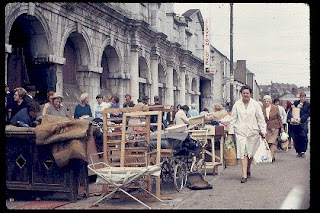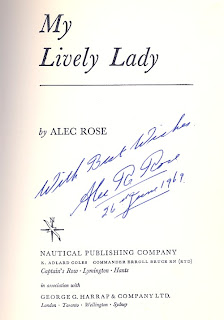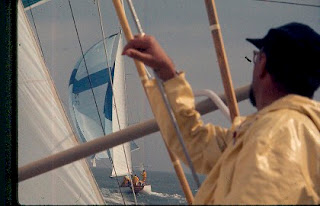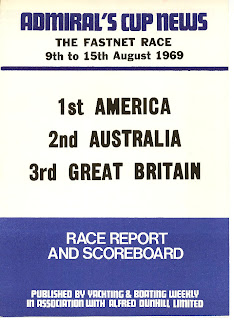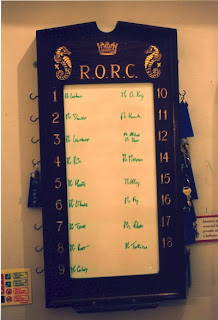Now that I have a go pro and another waterproof video camera. I am always impressed with the video that others are able to shoot and edit. The emphasis being on edit. I am still struggling with this aspect; but enjoying video more every day.
Category: cowes week
12 meter racing before 1958
http://www.britishpathe.com/record.php?id=1079
Leading up to the 12 meter era reunion, this should amuse those who sailed competitively on 12 meters
CARINA
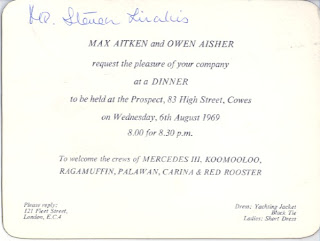
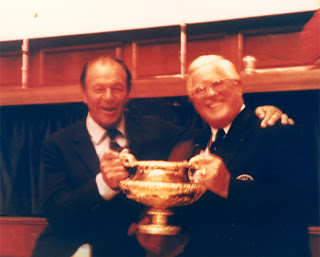

This weekend at the Indian Harbor Yacht Club will be a reunion of as many “Carina” crew as can be rounded up to recount their memories of sailing on perhaps the most famous boat in ocean racing.
COWES WEEK FASTNET RACE 2009
Hobnail Boots

 After arriving in Ireland at the finish of the Trans-atlantic race; I was informed that I was included on the list of invited to all the events in Cowes; which meant that I would need a dinner jacket and other appropriate clothes.
After arriving in Ireland at the finish of the Trans-atlantic race; I was informed that I was included on the list of invited to all the events in Cowes; which meant that I would need a dinner jacket and other appropriate clothes.
Admiral’s cup 1969
 1969 was my first Admiral’s Cup and first Fastnet Race. The Admiral’s Cup team: Carina, Palawan, and Red Rooster. The Dick Carter designed Red Rooster was chosen for the team before she hit the water. It proved to be a good choice.
1969 was my first Admiral’s Cup and first Fastnet Race. The Admiral’s Cup team: Carina, Palawan, and Red Rooster. The Dick Carter designed Red Rooster was chosen for the team before she hit the water. It proved to be a good choice.
Royal Ocean Racing Club
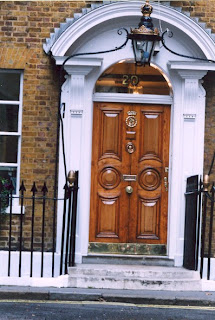 No club has been more important in my sailing career than the Royal Ocean Racing Club. I joined in 1969; shortly after finishing the Fastnet race and having won the Admiral’s Cup, sailing aboard “Carina”. One of the conditions of membership is to have completed a number of the Club’s races offshore. A true yacht club. I live in the United States, however I have completed 4 Admiral’s Cups, and 5 Fastnet races as well as many of the Clubs other races. I try to stay in touch with events at the RORC.
No club has been more important in my sailing career than the Royal Ocean Racing Club. I joined in 1969; shortly after finishing the Fastnet race and having won the Admiral’s Cup, sailing aboard “Carina”. One of the conditions of membership is to have completed a number of the Club’s races offshore. A true yacht club. I live in the United States, however I have completed 4 Admiral’s Cups, and 5 Fastnet races as well as many of the Clubs other races. I try to stay in touch with events at the RORC.
Admiral’s Cup 1971
 Following our delivery across the ocean “Carina” was hauled out of the water at Camper & Nicholson’s yard in Gosport. it made sense because the first race, the Channel race started at Southend closeby. The team was comprised of “Yankee Girl”, “Bay Bea”, and “Carina” Bill Snaith, however was chosen to be the team captain, in Cowes without a boat.
Following our delivery across the ocean “Carina” was hauled out of the water at Camper & Nicholson’s yard in Gosport. it made sense because the first race, the Channel race started at Southend closeby. The team was comprised of “Yankee Girl”, “Bay Bea”, and “Carina” Bill Snaith, however was chosen to be the team captain, in Cowes without a boat.
Fall 1975
 Following Cowes Week aboard “Gitana VI” I raced the Fastnet with “Guia” belonging to Georgio Falk. “Guia” had been built for the previous Admiral’s Cup as “Ginko” a 44 foot Bob Miller/Ben Lexan design. A light fast boat, having scored well in 1973 and had won an inshore race in 1975. Again, a mixed crew of talented Italians and French, and again English was the language on Deck, except when faced with a crisis.
Following Cowes Week aboard “Gitana VI” I raced the Fastnet with “Guia” belonging to Georgio Falk. “Guia” had been built for the previous Admiral’s Cup as “Ginko” a 44 foot Bob Miller/Ben Lexan design. A light fast boat, having scored well in 1973 and had won an inshore race in 1975. Again, a mixed crew of talented Italians and French, and again English was the language on Deck, except when faced with a crisis.







